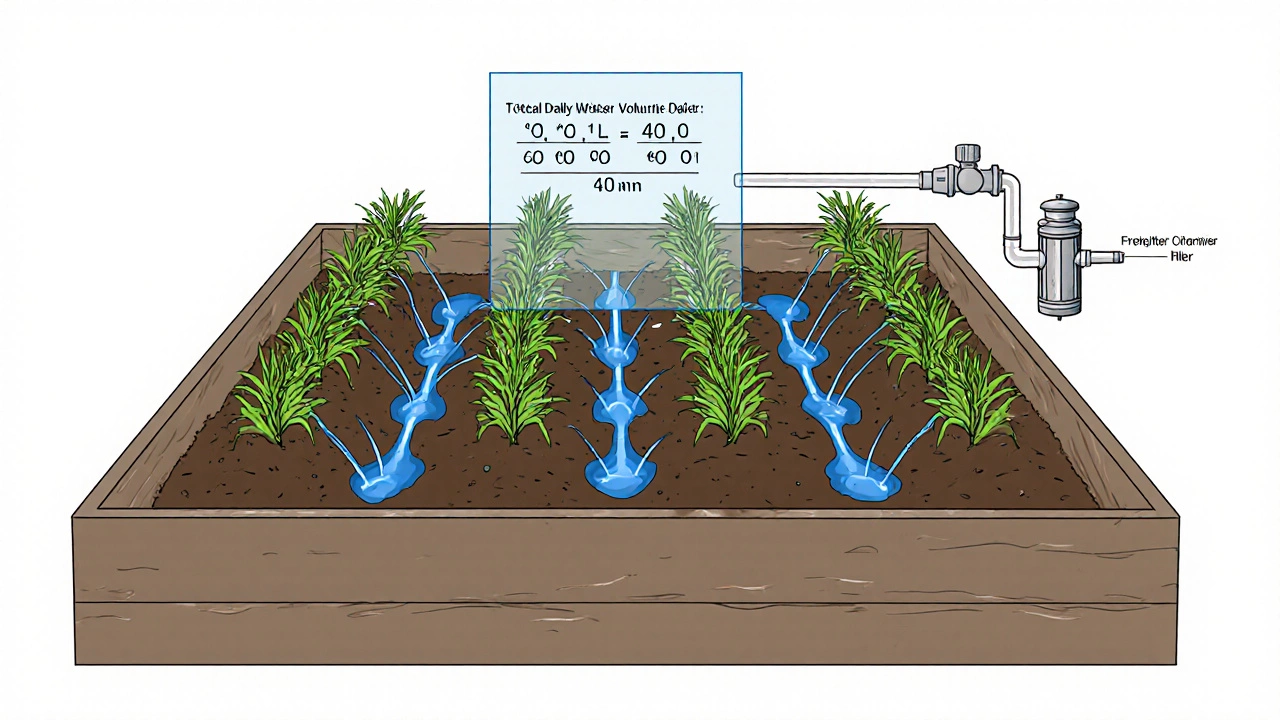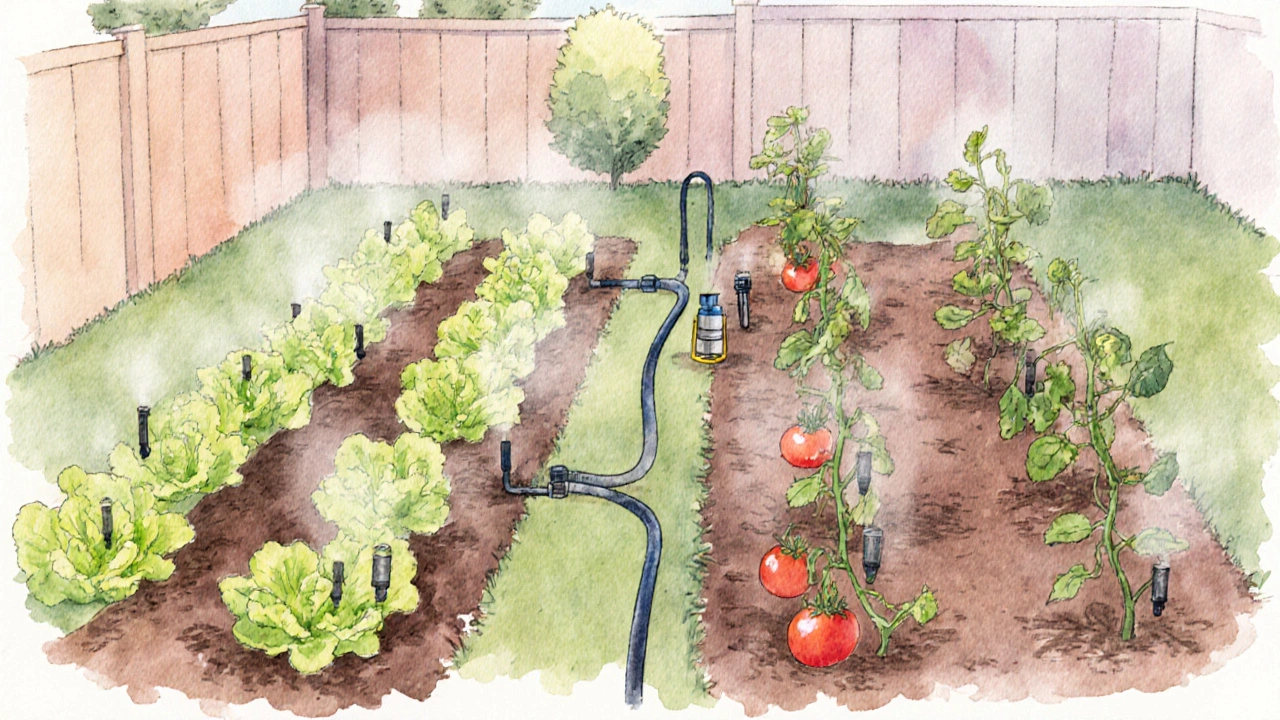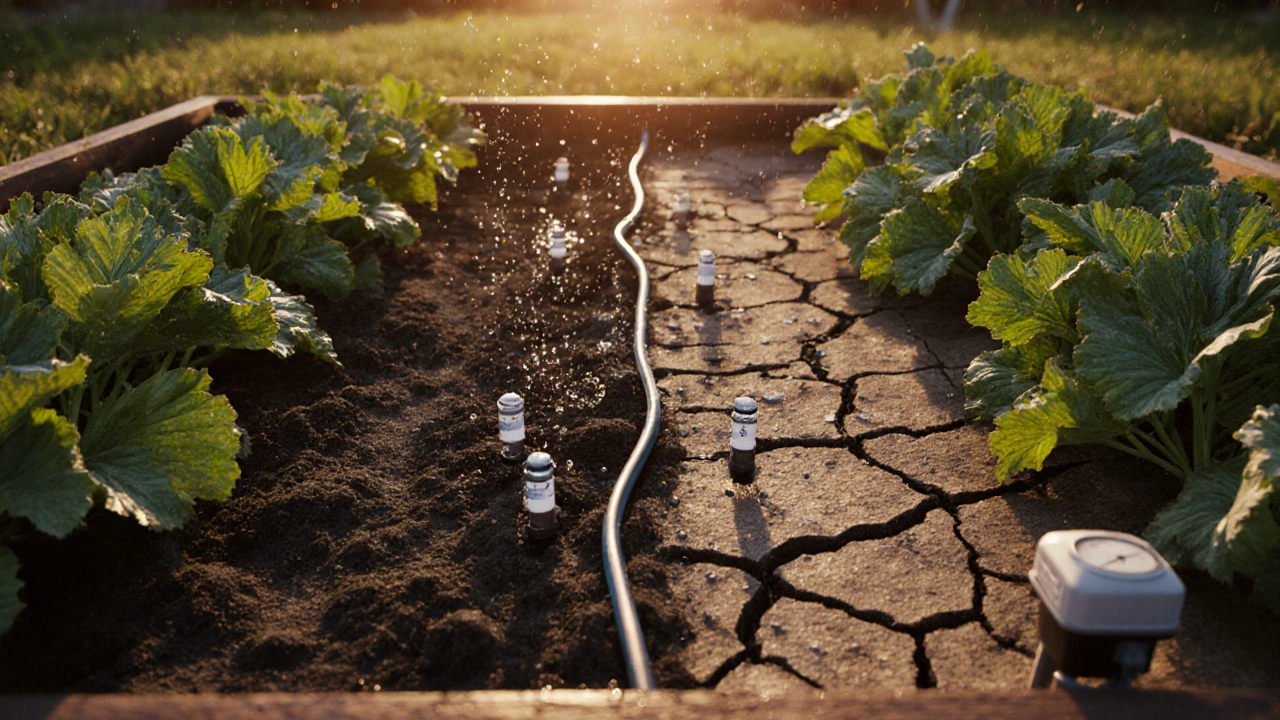Drip Irrigation Emitter Calculator
Drip Irrigation Emitter Calculator
Calculate the exact number of emitters needed for your garden zone based on your plant's water requirements, emitter flow rate, and runtime.
Total Daily Water Needed:
Water per Emitter per Run:
Number of Emitters Needed:
Recommended Spacing:
For optimal results:
- Ensure emitter spacing matches recommended guidelines
- Consider splitting large zones into multiple zones
- Use a pressure regulator and filter for consistent performance
Ever wondered why part of your garden stays soggy while another patch stays bone‑dry, even though you set the timer the same way? The culprit is often the number of emitters you’ve packed into each zone. Getting the count right can mean the difference between a thriving vegetable patch and a wilted mess.
What Makes a Drip Zone Tick?
Before diving into numbers, let’s lock down the key players.
Drip emitter is a small device that releases water at a set flow rate - typically measured in liters per hour (L/h) - directly onto a plant’s root zone. It’s the workhorse of any drip irrigation zone, which is a section of the garden fed by the same pressure and flow characteristics.
Two other silent partners are flow rate, the volume of water moving through a pipe per unit time (L/h), and pressure, the force that pushes water through the system, usually expressed in pounds per square inch (psi) or kilopascals (kPa).
Each plant’s water requirement - often quoted as millimetres of water per day (mm/day) - tells you how much water its roots need to stay healthy.
To protect the system from debris, a filter catches particles before they reach the emitters, while a pressure regulator ensures the pressure stays within a narrow band, preventing over‑ or under‑watering.
All of these elements are tied together by tubing, the network that delivers water from the source to each emitter.
Step 1: Pin Down Your Plant’s Water Need
Start with the daily water requirement for the crops you’re growing. Here’s a quick reference (values are averages for UK conditions):
- Leafy greens - 3-4mm/day
- Tomatoes - 5-6mm/day
- Root veg (carrots, beetroot) - 4-5mm/day
- Herbs - 2-3mm/day
Convert the depth (mm) to a volume per square metre by remembering that 1mm of water over 1m² equals 1liter. So, a tomato patch needing 5mm/day requires 5L per m² each day.
Step 2: Choose the Right Emitter Flow Rate
Emitters come in a range of flow rates, typically 0.5L/h (low), 1L/h (standard), 2L/h (medium), and 4L/h (high). The right choice balances two things: the total water you need and the length of time you can run the system without exceeding your water‑budget or causing runoff.
| Flow Rate (L/h) | Ideal Plant Type | Typical Spacing (cm) |
|---|---|---|
| 0.5 | Small herbs, seedlings | 30-45 |
| 1.0 | Leafy greens, basil | 45-60 |
| 2.0 | Tomatoes, peppers | 60-90 |
| 4.0 | Fruit trees, large vines | 90-120 |
For a typical backyard vegetable bed, the 2L/h emitter hits the sweet spot - enough flow to meet the demand without stretching the run‑time beyond 30minutes.

Step 3: Do the Math - How Many Emitters per Zone?
Now the core formula:
- Calculate total daily water volume for the area (L=mm×area in m²).
- Choose an emitter flow rate (L/h).
- Decide how many hours you’ll run the system each day (usually 30-60minutes).
- Emitters needed = (Total daily volume) ÷ (Emitter flow rate × Run‑time hours).
Let’s walk through a real‑world example.
Example: You have a 4m×2m (8m²) raised bed of tomatoes needing 5mm/day.
- Daily water = 5L/m² × 8m² = 40L.
- Choose a 2L/h emitter.
- Plan to run the system for 30minutes (0.5h) each day.
- Water delivered per emitter per run = 2L/h × 0.5h = 1L.
- Emitters needed = 40L ÷ 1L ≈ 40 emitters.
That sounds like a lot, but remember you can split the bed into two zones, each with its own timer, or use higher‑flow emitters (4L/h) to halve the count. The goal is to keep emitter spacing practical - roughly 30-45cm apart for tomatoes.
Step 4: Design the Zone for Even Distribution
Even water delivery hinges on three technical details:
- Pressure uniformity: A pressure regulator set to 10-15psi (70-100kPa) smooths out variations caused by elevation changes.
- Tube sizing: Use 16mm (½‑inch) mainline for up to 30L/h, stepping down to 12mm (¾‑inch) laterals for longer runs. Larger tubing reduces friction loss, keeping pressure steady across the farthest emitter.
- Filtering: Install a screen filter (100µm) right after the pump. It captures sand and debris that would otherwise clog low‑flow emitters.
When you layout the tubing, aim for a “loop” design: water travels to the far end and then back to the source, giving the farthest emitters the same pressure as the closest ones.
Step 5: Fine‑Tune with a Quick Checklist
- Confirm daily water requirement for each crop.
- Pick an emitter flow rate that matches the required run‑time.
- Run the emitter‑count formula for each zone.
- Group plants with similar needs into the same zone.
- Install a pressure regulator set to 10-15psi.
- Use a filter rated at 100µm or finer.
- Check emitter spacing - usually 30-90cm depending on flow.
- Test the system after installation: run for 5minutes, then measure flow at the farthest emitter. Adjust regulator or tubing size if pressure drop exceeds 2psi.

Common Pitfalls and How to Fix Them
Uneven watering. If the outer edge stays dry, you likely have too much friction loss. Solution: upsize the mainline or add a second regulator downstream.
Clogged emitters. Low‑flow emitters (0.5L/h) are most vulnerable. Flush the system weekly with a brief high‑pressure burst, and replace any emitter that stays dry.
Over‑watering. Happens when you underestimate run‑time or use a higher‑flow emitter than calculated. Reduce the timer or switch to a lower‑flow emitter.
Pressure spikes. Sudden pump shutdown can cause bursts that damage emitters. Install a pressure‑release valve near the pump.
Putting It All Together - A Sample Layout
Imagine a 10‑m² garden split into two zones: ZoneA for lettuce (low‑flow, 0.5L/h) and ZoneB for tomatoes (medium‑flow, 2L/h). Using the steps above, you’ll end up with about 12 emitters in ZoneA (run 1hour) and 20 emitters in ZoneB (run 30minutes). Both zones share the same mainline, a 16mm pipe, a 12psi regulator, and a 100µm filter. The result? Consistent soil moisture, no soggy spots, and a healthier harvest.
Frequently Asked Questions
How do I decide between 1L/h and 2L/h emitters?
Pick the flow that lets you finish watering within 30-60minutes without exceeding your pump’s capacity. For high‑water‑need crops like tomatoes, 2L/h often cuts the emitter count in half while keeping run‑time reasonable.
Can I mix different emitter flow rates in the same zone?
It’s not recommended because the zone’s total flow calculation assumes uniform emitters. Mixing creates hot spots and makes timer settings inaccurate. Instead, separate plants with different needs into distinct zones.
What’s the best way to check pressure loss across a zone?
Attach a pressure gauge at the start of the zone and another at the farthest emitter. The difference should be less than 2psi. If it’s higher, either increase tubing diameter or add a secondary regulator.
How often should I clean the filter?
Inspect it every two weeks during the growing season. If water flow drops noticeably, give it a rinse or replace the screen. In dusty areas, weekly checks are safer.
Is it okay to run the system at night?
Yes, night watering reduces evaporation. Just make sure the soil isn’t frozen and that you don’t create a breeding ground for fungal diseases - aim for early evening or pre‑dawn timing.

